Orthogonal-Frequency Simultaneous Wireless Power and Data Transfer for High-Power Wireless EV Charging
Abstract
1. Introduction
- This paper proposes an OF-SWPDT technique that eliminates spectrum interference from power harmonics. By optimizing the carrier frequency and bandwidth, the SNR of the communication channel is enhanced, enabling higher transmission power. A 64.125 kbps communication link is achieved in an 11 kW WPT system, which demonstrates the possibility of achieving full-duplex high-speed communication in high-power applications.
- A plug-and-play toroidal transformer is proposed to inject and extract data carriers simultaneously, simplifying installation and facilitating migration to various WPT systems. Data can be correctly transferred without adding additional wave trappers to the WPT system.
2. Principle of the OF-SWPDT Technique
- The frequency of the data carrier (fd) is an even integer multiple (kd) of the fundamental frequency of the power carrier (fp).
- The symbol duration Ts is an integer multiple (ks) of the fundamental period of the power carrier (1/fp).
3. Analysis of Data Transmission
3.1. Structure of Plug-and-Play Toroidal Transformer
3.2. Data Modulating and Demodulating
4. Communication Channel Modeling
4.1. Data Transfer Gain
4.2. Interference Analysis
5. Experimental Verification
6. Conclusions
Author Contributions
Funding
Data Availability Statement
Conflicts of Interest
References
- Jeong, S.; Jang, Y.J.; Kum, D. Economic analysis of the dynamic charging electric vehicle. IEEE Trans. Power Electron. 2015, 30, 6368–6377. [Google Scholar] [CrossRef]
- Covic, G.A.; Boys, J.T. Modern trends in inductive power transfer for transportation applications. IEEE J. Emerg. Sel. Top. Power Electron. 2013, 1, 28–41. [Google Scholar] [CrossRef]
- Chen, H.; Cheng, Z.; Qian, Z.; Wu, J.; He, X. Application of SWPDT in the Feedback Control of Wireless EV Charging. In Proceedings of the 2020 IEEE Energy Conversion Congress and Exposition (ECCE), Detroit, MI, USA, 11–15 October 2020. [Google Scholar]
- Li, C.; Huang, H.; Li, L. State monitoring system based on wireless charging. In Proceedings of the 2019 IEEE International Conference on Energy Internet (ICEI), Nanjing, China, 27–31 May 2019. [Google Scholar]
- Yao, Y.; Tang, C.; Gao, S.; Wang, Y.; Alonso, J.M.; Madawala, U.K.; Xu, D. Analysis and design of a simultaneous wireless power and data transfer system featuring high data rate and signal-to-noise ratio. IEEE Trans. Ind. Electron. 2021, 68, 10761–10771. [Google Scholar] [CrossRef]
- Chen, H.; Liu, C.; Zhang, Y.; Liu, S.; Wu, J.; He, X. Metal Object and Vehicle Position Detections Integrated With Near-Field Communication for Wireless EV Charging. IEEE Trans. Veh. Technol. 2022, 71, 7134–7146. [Google Scholar] [CrossRef]
- Yao, Y.; Sun, P.; Liu, X.; Wang, Y.; Xu, D. Simultaneous wireless power and data transfer: A comprehensive review. IEEE Trans. Power Electron. 2022, 37, 3650–3667. [Google Scholar] [CrossRef]
- Hoeher, P.A. FSK-based simultaneous wireless information and power transfer in inductively coupled resonant circuits exploiting frequency splitting. IEEE Access 2019, 7, 40183–40194. [Google Scholar] [CrossRef]
- Kim, J.G.; Wei, G.; Kim, M.H.; Ryo, H.S.; Zhu, C. A wireless power and information simultaneous transfer technology based on 2FSK modulation using the dual bands of series–parallel combined resonant circuit. IEEE Trans. Power Electron. 2019, 34, 2956–2965. [Google Scholar] [CrossRef]
- Qian, Z.; Yan, R.; Wu, J.; He, X. Full-duplex high-speed simultaneous communication technology for wireless EV charging. IEEE Trans. Power Electron. 2019, 34, 9369–9373. [Google Scholar] [CrossRef]
- Wang, P.; Sun, Y.; Feng, T.; Fan, Y.; Feng, Y. Simultaneous wireless power and data transfer system with full-duplex mode based on double-side LCCL and dual-notch filter. IEEE J. Emerg. Sel. Top. Power Electron. 2021, 10, 3140–3151. [Google Scholar] [CrossRef]
- Jing, Y.; Feng, W.; Qiao, K.; Yang, L.; Wang, S.; Lu, L. Simultaneous Wireless Power and Data Transfer System With Full-Duplex Mode Based on LCC/CLC Resonant Network. IEEE Trans. Power Electron. 2023, 38, 5549–5560. [Google Scholar] [CrossRef]
- Wang, K.; Sanders, S. Contactless USB—A capacitive power and bidirectional data transfer system. In Proceedings of the 2014 IEEE Applied Power Electronics Conference and Exposition-APEC, Fort Worth, TX, USA, 16–20 March 2014. [Google Scholar]
- Yao, Y.; Cheng, H.; Wang, Y.; Mai, J.; Lu, K.; Xu, D. An FDM-based simultaneous wireless power and data transfer system functioning with high-rate full-duplex communication. IEEE Trans. Ind. Inform. 2020, 16, 6370–6381. [Google Scholar] [CrossRef]
- Wang, P.; Sun, Y.; Feng, Y.; Feng, T.; Fan, Y.; Li, X. An improvement of SNR for simultaneous wireless power and data transfer system with full-duplex communication mode. IEEE Trans. Power Electron. 2022, 37, 2413–2424. [Google Scholar]
- Ji, L.; Wang, L.; Liao, C.; Li, S. Simultaneous wireless power and bidirectional information transmission with a single-coil, dual-resonant structure. IEEE Trans. Ind. Electron. 2019, 66, 4013–4022. [Google Scholar] [CrossRef]
- Yao, G.; Guo, W.; Xiaoxiao, H. Study on Wireless Power and Information Synchronous Transfer Based on Dual Resonant Coupling Circuits. Trans. China Electrotech. Soc. 2015, 30, 18–25. [Google Scholar]
- Fan, Y.; Sun, Y.; Dai, X.; Zuo, Z.; You, A. Simultaneous wireless power transfer and full-duplex communication with a single coupling interface. IEEE Trans. Power Electron. 2021, 36, 6313–6322. [Google Scholar] [CrossRef]
- Wu, J.; Zhao, C.; Lin, Z.; Du, J.; Hu, Y.; He, X. Wireless power and data transfer via a common inductive link using frequency division multiplexing. IEEE Trans. Ind. Electron. 2015, 62, 7810–7820. [Google Scholar] [CrossRef]
- Sun, Y.; Yan, P.X.; Wang, Z.H.; Luan, Y.Y. The parallel transmission of power and data with the shared channel for an inductive power transfer system. IEEE Trans. Power Electron. 2016, 31, 5495–5502. [Google Scholar] [CrossRef]
- Wang, G.; Wang, P.; Tang, Y.; Liu, W. Analysis of dual band power and data telemetry for biomedical implants. IEEE Trans. Biomed. Circuits Syst. 2012, 6, 208–215. [Google Scholar] [CrossRef] [PubMed]
- Bieler, T.; Perrottet, M.; Nguyen, V.; Perriard, Y. Contactless power and information transmission. IEEE Trans. Ind. Appl. 2002, 38, 1266–1272. [Google Scholar] [CrossRef]
- Li, X.; Hu, J.; Li, Y.; Wang, H.; Liu, M.; Deng, P. A decoupled power and data-parallel transmission method with four-quadrant misalignment tolerance for wireless power transfer systems. IEEE Trans. Power Electron. 2019, 34, 11531–11535. [Google Scholar] [CrossRef]
- Fan, Y.; Hu, H.; Sun, Y.; Hu, H.; Wu, S. Simultaneous Wireless Power and Coil Inductance Insensitive Data Transfer System for Rotary Structures. IEEE Trans. Power Electron. 2024, 39, 6526–6536. [Google Scholar]


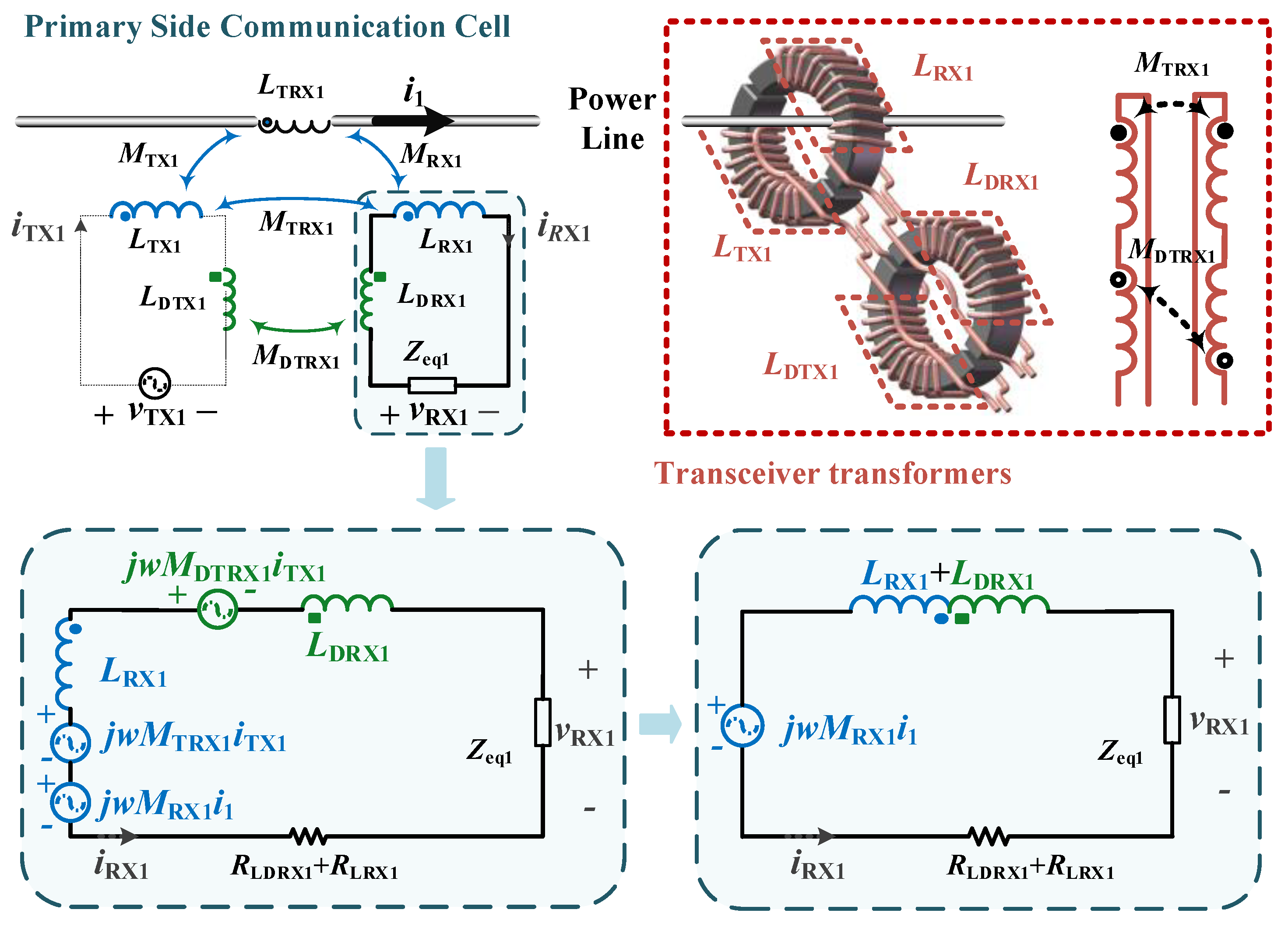
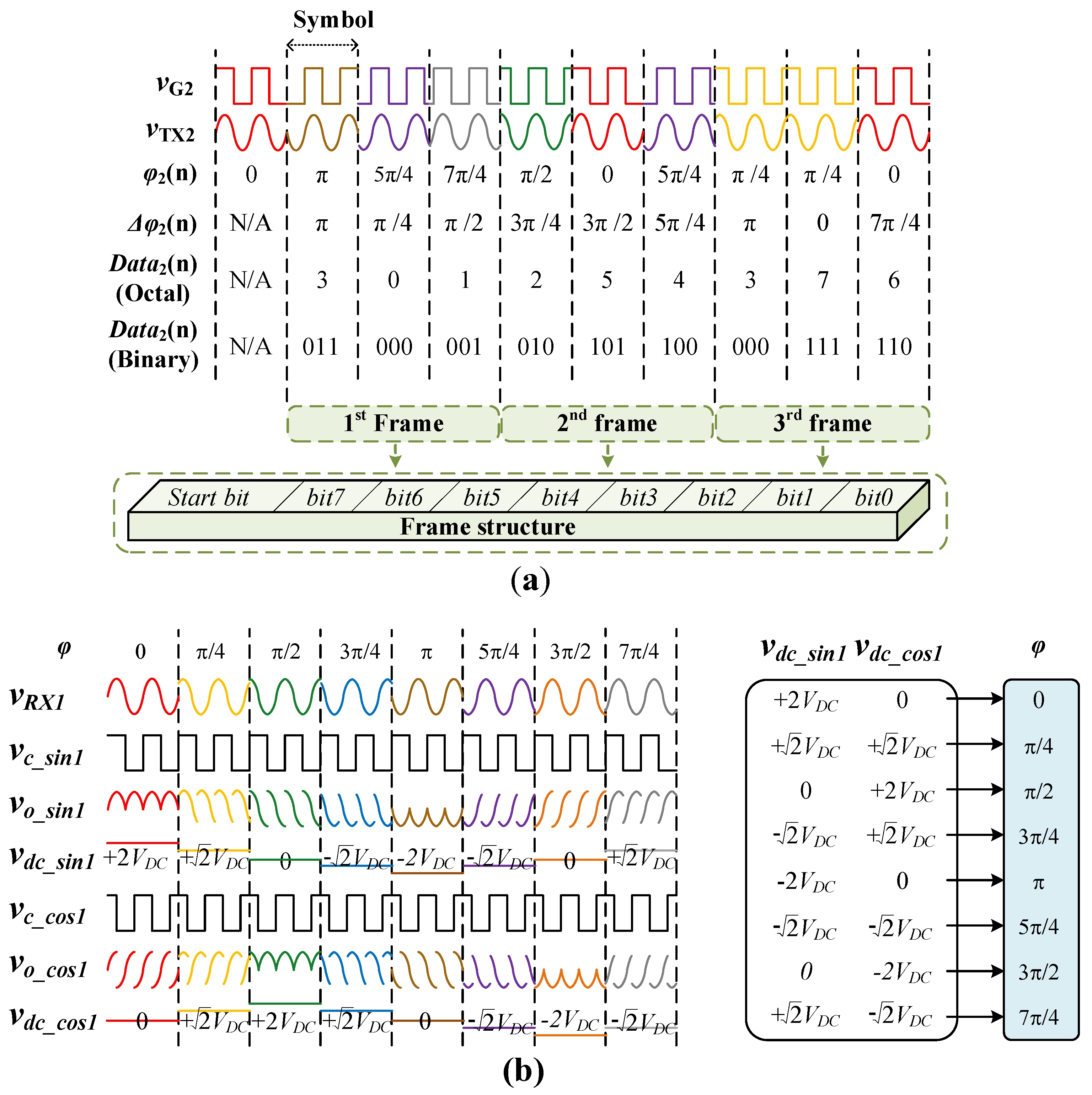
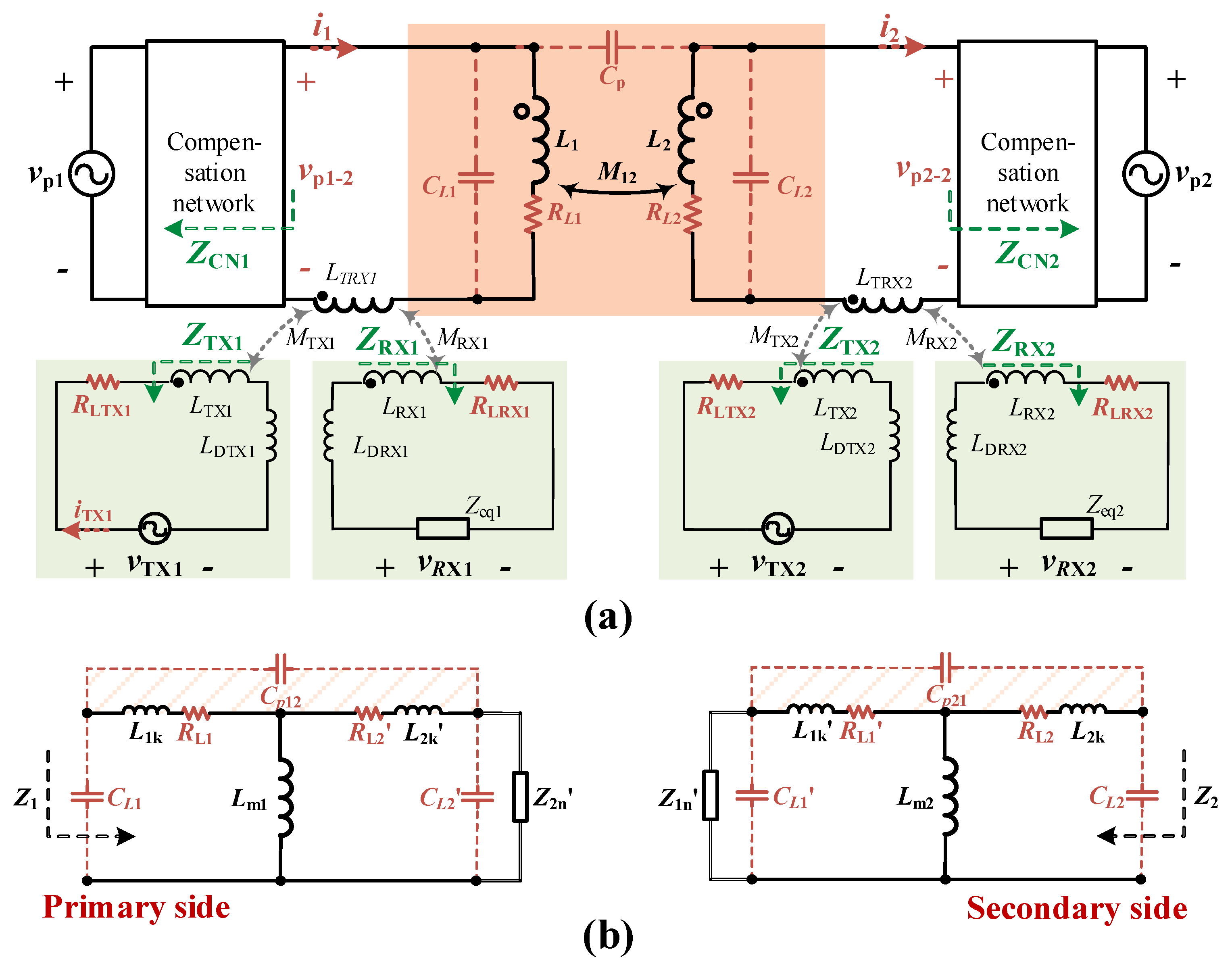

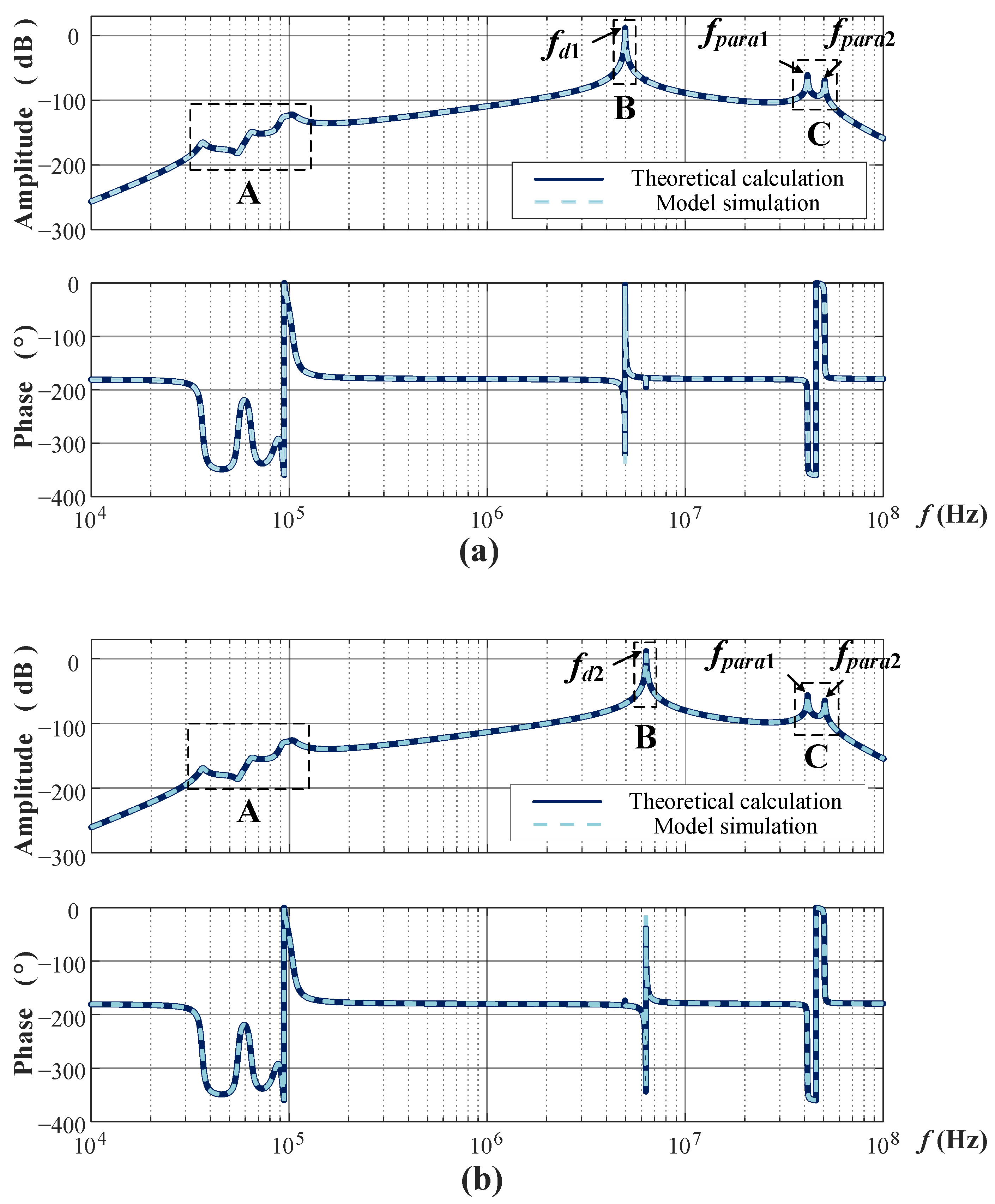





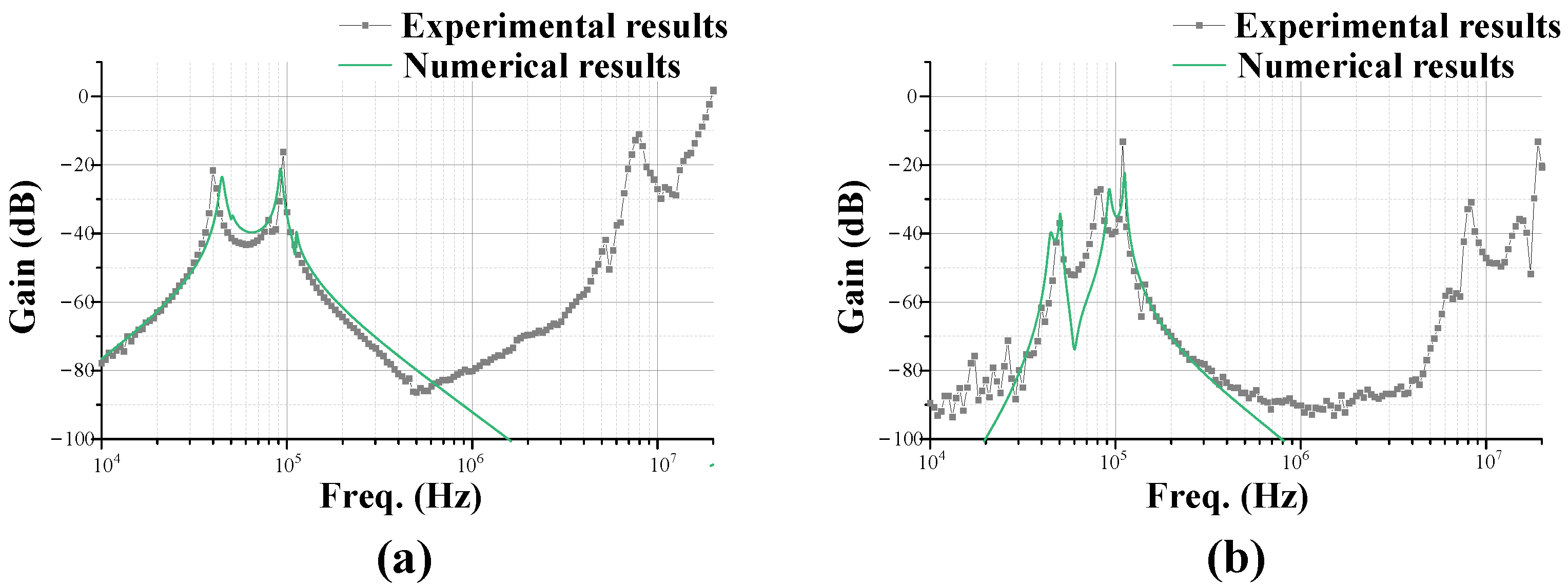




| Symbol | Value | Description | |
|---|---|---|---|
| WPT System | fp | 85.5 kHz | Switching frequency |
| P | 11 kW | Transferred power | |
| η | 91% | Power transmission efficiency | |
| L1, L2 | 41.7 μH, 38.8 μH | Inductive coupled coils | |
| M12 | 4.94 μH | Mutual inductance between L1 and L2 | |
| RL1, RL2 | 0.12 Ω, 0.1 Ω | Parasitic resistor of L1 and L2 | |
| C1, C2 | 126 nF, 157 nF | Compensation capacitors | |
| Cf1, Cf2 | 273 nF, 205 nF | Compensation capacitors | |
| Lf1, Lf2 | 26 μH, 16 μH | Compensation inductors | |
| RL | 43 Ω | Load Resistor | |
| S1~S4 | IPW65R080CFD | Power inverter switches | |
| D1~D4 | IDW30S120 | Power rectifier diodes | |
| Communication System | fd1, fd2 | 4.959 MHz, 6.327 MHz | Frequency of data carriers |
| Pd1, Pd2 | 1.7 W, 1.4 W | Power consumptions of data transmitting | |
| LTX1, LTX2 | 2.2 μH, 2.56 μH | Data-injecting inductors | |
| LRX1, LRX2 | 7.28 μH, 6.50 μH | Data-extracting inductors | |
| Req | 4.88 kΩ | Data extractor equivalent resistor |
| Signal (dBV) | Noise (dBV) | SNR (dB) | |
|---|---|---|---|
| Forward data transfer (4.96 MHz) | −3.6 | −39.8 | 36.2 |
| Backward data transfer (6.327 MHz) | −3.2 | −44.8 | 41.6 |
| Reference | This Work | [24], Year 2024 | [12], Year 2023 | [15], Year 2022 | [18], Year 2021 | [14], Year 2020 |
|---|---|---|---|---|---|---|
| Transferred power | 11 kW | 300 W | 20 W | 500 W | 600 W | 300 W |
| Power transmission efficiency | 91% | 90.5% | 80% | 84% | 85% | 90.1% |
| Maximum data transfer rate | 64.1 kbps | 40 kbps | 250 kbps | 600 kbps | 80 kbps | 500 kbps |
| Power consumption from data transmission | 1.7 W, 1.4 W | - | - | - | - | 2 W |
| Modulation | 8DPSK | ASK | ASK | ASK | ASK | FSK |
| SNR | 36.2 dB | - | - | 32 dB | 8.6 dB | 20 dB |
| Communication mode | Full-duplex | Full-duplex | Full-duplex | Full-duplex | Full-duplex | Full-duplex |
Disclaimer/Publisher’s Note: The statements, opinions and data contained in all publications are solely those of the individual author(s) and contributor(s) and not of MDPI and/or the editor(s). MDPI and/or the editor(s) disclaim responsibility for any injury to people or property resulting from any ideas, methods, instructions or products referred to in the content. |
© 2024 by the authors. Licensee MDPI, Basel, Switzerland. This article is an open access article distributed under the terms and conditions of the Creative Commons Attribution (CC BY) license (https://creativecommons.org/licenses/by/4.0/).
Share and Cite
Liu, C.; Zhang, Y.; Chen, H.; Wu, J.; He, X. Orthogonal-Frequency Simultaneous Wireless Power and Data Transfer for High-Power Wireless EV Charging. Energies 2024, 17, 1851. https://doi.org/10.3390/en17081851
Liu C, Zhang Y, Chen H, Wu J, He X. Orthogonal-Frequency Simultaneous Wireless Power and Data Transfer for High-Power Wireless EV Charging. Energies. 2024; 17(8):1851. https://doi.org/10.3390/en17081851
Chicago/Turabian StyleLiu, Chengyin, Yi Zhang, Hao Chen, Jiande Wu, and Xiangning He. 2024. "Orthogonal-Frequency Simultaneous Wireless Power and Data Transfer for High-Power Wireless EV Charging" Energies 17, no. 8: 1851. https://doi.org/10.3390/en17081851
APA StyleLiu, C., Zhang, Y., Chen, H., Wu, J., & He, X. (2024). Orthogonal-Frequency Simultaneous Wireless Power and Data Transfer for High-Power Wireless EV Charging. Energies, 17(8), 1851. https://doi.org/10.3390/en17081851







